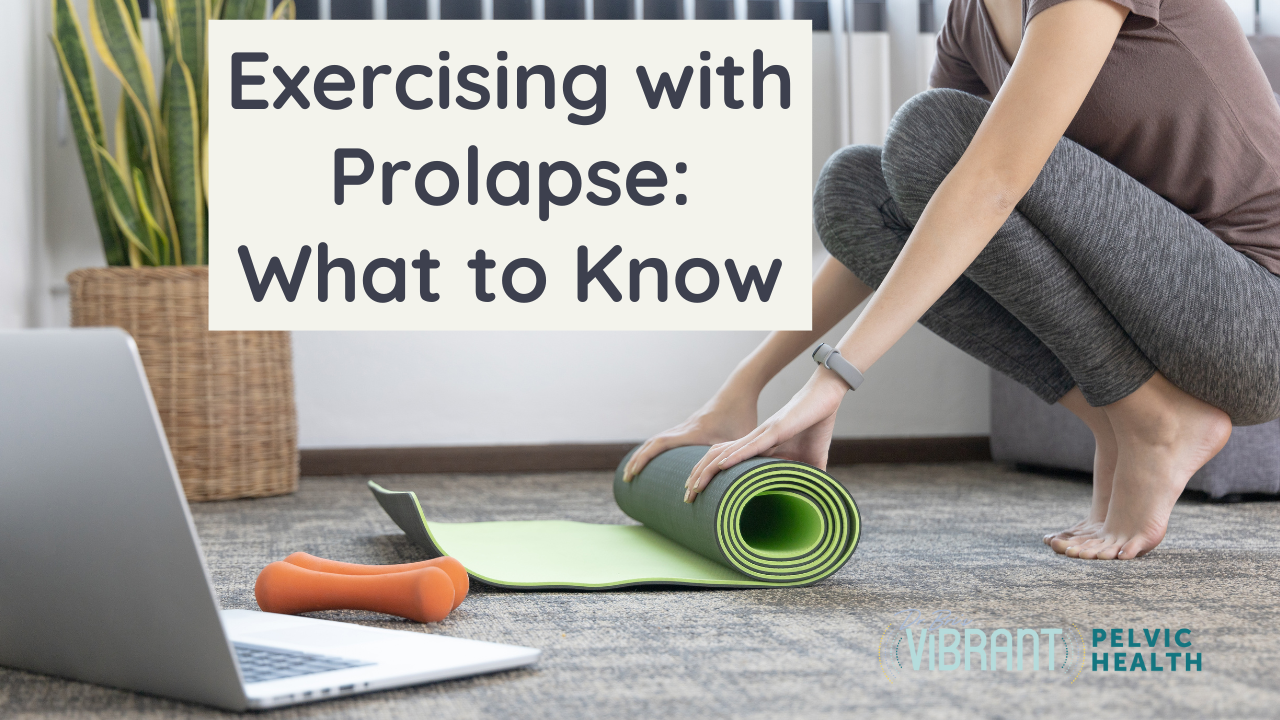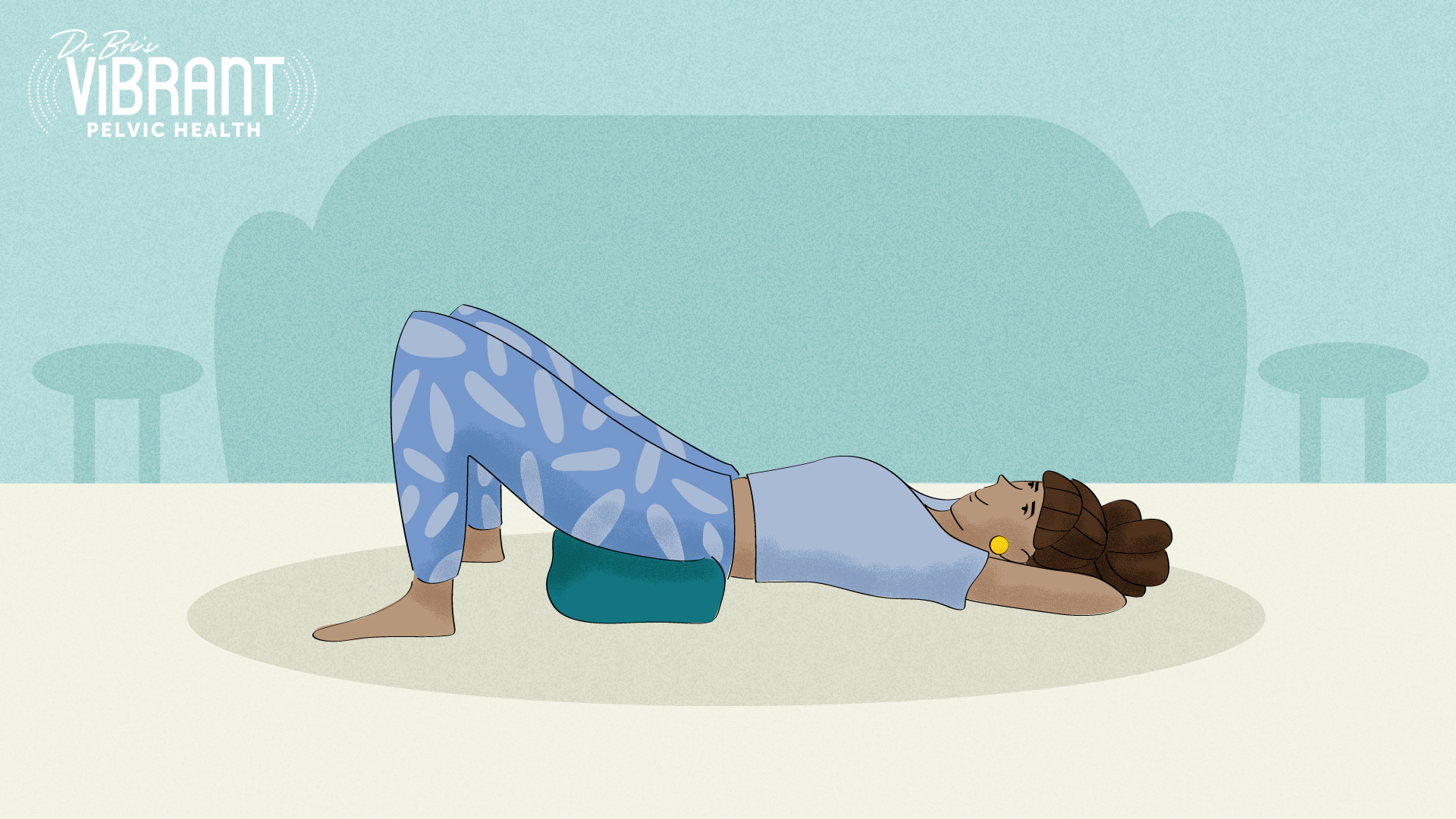Exercising with Prolapse - What to Know

If you have been diagnosed with prolapse, please know that there is help. There ARE things that you can do to reverse your symptoms and keep your body active and strong. If you're wondering about exercising with prolapse, then let me lay it out for you so that you can find the BEST solution and start living life with confidence and ease… even with a pelvic organ shift!
Exercise and Prolapse
Before we continue, please read this story of hope:
I've been a CrossFitter and triathlete for years — I was still lifting at 8 months pregnant and only stopped when my feet swelled so much I was no longer steady on them (and then I swam a km a day until delivery). I just assumed I'd be back in the gym 6 weeks after giving birth. Boy, was I wrong! I was diagnosed with a stage 2 anterior prolapse. I began seeing a women's health physio immediately but my symptoms weren't improving much. I was told it would be a year before I could even attempt high-impact exercise again if at all, which was devastating for me.
BUT... After the Lift program in combination with my physio exercises, I am seeing results! As long as I wear my EVB support garments, I can now go on long walks symptom-free. I now have hope that I will someday get back to CrossFit whereas I had little hope before.
I will say I started the Lift program the first few weeks and only did the exercises a few days a week and saw no results. I then decided to restart from week 1 and did them every day religiously and it was only then that I started to see results. My advice is you have to commit to this for it to work! Thank you so much for giving me hope.
~Happy Lift participant
Rushing to Get Back to Exercise
So many of us rush our bodies because we so desperately want to get "back to normal" after getting a prolapse diagnosis. I know… I’ve been there too! I rushed my body by running far too soon after I gave birth and developed my own mild bladder prolapse.
But there’s good news! Using my training as a women’s health physical therapist I put together a self-care plan using natural, conservative treatment measures (exercise and lifestyle modifications). Today, I’m symptom-free and I exercise every day. YOU CAN GET MOVING AGAIN TOO… Let’s talk about how!

Where to start if you have prolapse:
First, did you get a diagnosis from your doctor? Does something feel different “down there?” Did the doctor talk about the level or degree of your prolapse? Is it a uterine, bladder, or rectal prolapse? Prolapse is an under-discussed condition, and so if you feel like a newbie when it comes to prolapse, check out my beginner's guide here.
Pelvic organ prolapse (POP) is a shift in organs that often follows pregnancy, weight gain, or changes associated with aging. The best thing that you can do when you're just getting started with a POP diagnosis is to see a physical therapist who specializes in Pelvic Floor Physical Therapy (also commonly referred to as Women’s Health Physical Therapy).

Prolapse Exercise Essentials When You're Getting Started
IMPORTANT: When you're beginning a self-care program for POP, it's important to avoid extreme exertion exercises like running, jumping, heavy lifting, crunches, sit-ups, or planks… At least, at first.
You might be able to return to these activities with proper time and training, but hold off for now.
Also, you'll need to avoid or modify activities that cause a feeling of "bearing down" or downward pressure! Even lifting light weights (or pets, or kids!) and squatting needs to be done properly to prevent your symptoms from worsening.
We will cover some low-impact exercises and lifting strategies that are helpful below. But first, a summary of what you need to know when it comes to exercising with prolapse:
- Don't rush the recovery process; prolapse management is a lifestyle
- If you notice a vaginal bulge or feeling of pelvic heaviness or dragging, then stop and/or modify
- Break down challenging moves into easier pieces
- Gradually rebuild strength from there
- Be consistent with your fitness training
Choose Low-Impact
Even with prolapse, there is a LOT you can do to move your body safely, and in fact, it’s really important to stay active and strong in order to maintain your health, your energy, your mood, and your weight.
One great low-impact way to start back into exercising is to walk. Aim for 150 minutes per week (which is about 30 minutes/day, 5 days/week) as your ultimate goal, but if you're just getting started, start small! Even just 10-15 minutes/day is a great starting point.
Maintain good posture and breathe steadily (don’t hold your breath) while walking. Consider walking earlier in the day when your body has more energy (rather than later in the day when you’re more fatigued), and talk to your doctor about using a pessary if your prolapse is more severe.
Too cold outside to walk? Try this 30-min INDOOR low-impact prolapse-friendly workout instead. It's got cardio AND core!
Rest and Recover After
Pro Tip: After a walk or low-impact exercise session, put your hips up!!! Really! You need to rest and rejuvenate your pelvic floor so that it can continue to support you for the rest of the day. Think “bottom-up” to relieve pressure on your pelvic floor. All of your movements (and pressures) throughout the day add up, so be mindful of your pelvic floor and the work that it endures all day long. Resting for a few minutes on your back with your hips up on a pillow is a beautiful treat for your mind and body. Or try my “three-minute miracle.” It’s such a treat for a tired pelvic floor!

Squat and Lift with Care
One of the greatest myths out there about prolapse is that you can never lift or squat again. This is not true. Squatting and lifting are activities of daily life; you just need to learn how to do them safely (along with other types of exercise/movement).
I have some great videos about both squatting and lifting with prolapse:
With lifting, get close to the item you’re lifting, gently engage your pelvic floor, and exhale as you lift. When squatting, sit your bum back and keep your spine long (don’t hunch or round your back), and exhale as you come up to stand. Watch the above-linked videos to learn more, and ALWAYS listen to your body. Take baby steps. Go slow! Start by lifting lightweight items rather than heavy boxes or weights… And start by doing mini air squats rather than full deep yogic squats.
Exercise Mindfully
We’ve discussed extreme exertion exercises to avoid… We’ve talked about the importance of staying active via low-impact activities like walking… We’ve covered the importance of relieving pressure on your pelvic floor via hips-up rest breaks… And we’ve talked about squatting and lifting. But what about doing MORE???
Many people with POP can return to more intense activities such as hiking, running, and heavier weight lifting, but this requires a GUIDED gradual progression, such as what you'll find in my Lift program.
My Lift program addresses core fitness in a compassionate, holistic manner. The program begins by teaching you how to identify and release/relax your pelvic floor muscles FIRST, before moving into more intensive core strengthening.
You do NOT have to fear movement with prolapse. Just be gentle with yourself, go slow, and learn how to tune in. Working with a pelvic floor physical therapist and/or doing my at-home Lift program will teach you how.
If you have prolapse, just know that there is hope, and there is HELP for symptom relief. Some people even find that their issues no longer bother them (or are noticeable at all) after completing my Lift program and/or a course of pelvic health physical therapy. You don't have to go through this alone. Join me in my Lift program and get ready to FEEL BETTER!
Click to join me to strengthen your pelvic floor so that you can exercise again!
At-Home Prolapse Recovery Program
"I could not recommend this program enough. Firstly it empowered me. Prior to commencing the program I was unaware of how my everyday actions made my prolapse worse. I am now much more aware of my breathing, posture, and how to safely workout. My bladder prolapse was medically diagnosed as a 2.5 and now is mild (level 1)."
~Happy Lift Participant
*NOTE: This website in general, and this article specifically, is for general information and educational purposes only. It is not intended to diagnose or treat any medical condition, but rather to understand what options are available. Please seek the advice of a physician to properly diagnose your symptoms.
You might also like:
Does your pelvic floor need help?
Many women think they just need live with the changes they’re experiencing
“down there,” but this is NOT the case. Take the short quiz to find out if you have issues that can be solved naturally.







